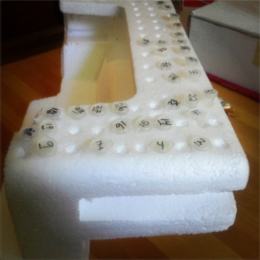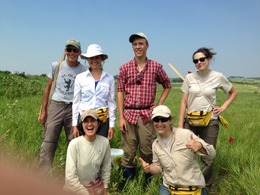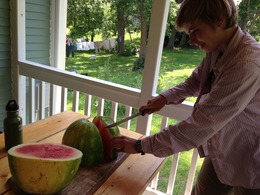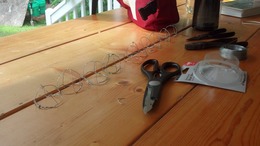|
|
It was another hot day on the prairie front. We all broke off into little groups today to take care of business. This morning Reina, Mike, and Pam assed herbivory in INB1 and INB2. Kory, Marie, Sarah B, and Dayvis were all scattered about working on their independent projects. Lydia and Sara Z assed the maternal plants in the common garden that are to be involved in the crosses of the quantitative genetic experiment, and on the other side of things Gretel, Shelley (Gretel’s Mother), Ruth and I went to Landfill Core to gather pollen from the sires that are to be involved in the crossing experiment. We used toothpicks to scrape off the pollen into vials that will be used for pollenating the maternal plants in the common garden. We were able to get pollen from about 40 of 55 plants at the site. The 15 others were just a little too immature to collect pollen from today.

This afternoon encompassed an hour of stipa searching for some and then continuation of some independent work on projects. Herbivory assessment continued as well. Stuart, Gretel, Ruth and I went for a nice long walk around SPP. We walked a U-shaped transect and used a randomized scheme for assigning sires to be used in the quantitative genetics experiment. We caged/bagged heads that were to be used and gps-ed the plants.
What a busy day!
Having dodged the misfortune of convening on Friday the thirteenth, Team Echinacea had a fruitful day in the field.
The morning was occupied by independent projects. Kory, Jennifer, and Jon went to CG2 at Hegg Lake to look for pollinators visiting flowering Echinacea. Dayvis and Marie also went to Hegg Lake to gather data for their respective projects. Sarah B. once again visited multiple remnants to monitor flowering dates. Meanwhile, Lydia, Ilse, and Gretel assessed phenology and flowering head count in the Common Garden and ’99 South Garden to gear up for this summer’s pollination experiment.
In the afternoon, Pam and Reina finished taking measurements of plants in INB2 for their study. The progress of their work benefited greatly from the recent acquisition of a Red Flyer wagon. Lydia (shown below) braved the wrath of protective ants in her quest to acquire blue aphids for her addition/ exclusion experiment. The rest of the team returned to CG2 to finish measuring plant fitness traits.

After a long day’s work, Dayvis cooked up a delicious meal of split pea soup and arepas (Venezuelan corn cakes). Many crew members are experiencing discomfort due to chigger bites, although some are more prone to vocalize their displeasure than others.
Today was a great day for Team Echinacea. Most of us began our mornings searching for stipa and then went out to Hegg Lake where we finished measuring plants in Jennifer’s common garden! Woot woot! I took an photo of the group and was so excited that my finger made it into the photo…whoops! Dayvis continued to observed pollinators and Reina and Pam were super productive measuring photosynthetic rates of plants in INB2 (maybe it’s the new wagon they got for lugging around Helga).

At lunch Kory updated us with his progress on his pollinator efficiency project and Jennifer surprised us with a delicious watermelon as a treat for finishing up stuff at Hegg Lake. Marie did the honors of cutting up the watermelon (little did we know it was her first time).

The afternoon felt a bit like deja vu of the morning. We did another round of searching for stipa (rumor has it we’re just about half way done!) and then returned to Hegg Lake. Turns out we didn’t actually “finish” measuring plants…now it’s time to double check all the ones we didn’t find the first time. Looks like we’ll finish that up tomorrow though, and then be actually done with Hegg Lake for the weekend.
Happy Thursday!
Today, the weather was beautiful and the team was able to make a lot of progress on several projects. In the morning, twist-tieing the heads in the common garden was finished up after several days of working on it. Most of the team then headed out to Hegg Lake to make a ton of progress inventorying the status of all the echinacea plants in common garden 2. My day consisted on making huge strides in gathering data on photosynthetic rate of the echinacea in the INB2 part of the common garden. We are almost 2/3 of the way done measuring! Later that day and back at the town hall, the team feasted on some delicious fajitas that Sarah Z. prepared for supper. 
-Reina
Today in Douglas County, Minnesota, Team Echinacea labored under a cloudless sky and oppressively high temperatures and humidity levels.
First thing in the morning, Sarah B. visited the remnants she is monitoring to study flowering phenology. Dayvis also departed to work on his own project, and was not seen again until 1pm. Today is the second day of flowering for Echinacea pallida at Hegg Lake, and Dayvis appeared elated to finally observe pollinators at work. Kory and Jennifer also went to Hegg Lake in the morning to visit Common Garden 2.
Those who did not have morning projects to attend to flagged and twist-tied flowering plants in the Common Garden. After lunch, the team departed to CG2 to measure plants. Throughout the day, Pam and Reina measured photosynthesis rates in the basal leaves of Echinacea in INB2. Marie and Reina also made/improvised pollinator exclusion cages. The technique for doing so remains unperfected.

Four plants are flowering in Andrea’s garden this year. Andrea Southgate planted this experiment (aka inb2) in 2006 as part of her Master’s research project. Andrea and Jennifer made a photo essay about their plantings that year. These are the first plants to flower in this experiment–about 4/1500 in their fifth growing season!
Yesterday we finished measuring in the Common Garden! Here are some details about the protocol used for 2009:
Gardens: Inbreeding & INB2 we used the same form as in 2008. Basal and Flowering Rosettes were counted separately. Crisp leaves were included in the leaf counts.
Gardens: 2001, Monica’s, SPP, Big Batch, and 96-99 we used an abbreviated form. We did not record data on insect damage. Insects on all rosettes (basal and flowering) were recorded on the main form. Insects on the heads were recorded on the subform. Cauline leaves were not counted. The longest cauline leaf (longest leaf on the tallest flowering rosette) was recorded on the main form. For basal leaves, crisp leaves were included in leaf counts and also noted, as were leaves that were “gone.” Pips or duds with no florets were only recorded if there was a peduncle long enough for a twist-tie collar.
Staples mark positions in the Common Garden where plants have died. Our policy has been to add a staple to a position where a plant has not been found for 3 years. This year, we’ve followed that protocol for the Inbreeding and INB2 gardens. However, we have added staples in Big Batch, 2001, SPP, Monica’s, 1996, 1997, 1998, 1999, and 1999s where plants have only been “Can’t Find” for TWO years. This should minimize the time it takes to search positions. We hope that plants and staples won’t both be found at the same position in the future.
|
|






